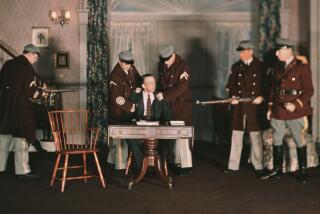A ‘Narnia’ C.S. Lewis might love
C.S. LEWIS, bookish and scholarly man that he was, rarely went to the movies. An evening of Wagnerian opera was more to his taste. But he could occasionally be tempted -- especially if it was a Disney film.
In January of 1939, for instance, before the new term drew him back to his duties as a tutor at Oxford University, he managed to catch the then relatively new movie, “Snow White and the Seven Dwarfs.” A few days later, he wrote to a friend about it. “Leaving out the tiresome question of whether it is suitable for children (which I don’t know and I don’t care) I thought it almost inconceivably good and bad.”
For the record:
12:00 a.m. Dec. 10, 2005 For The Record
Los Angeles Times Saturday December 10, 2005 Home Edition California Part B Page 21 Editorial Pages Desk 1 inches; 60 words Type of Material: Correction
Narnia: An essay Monday about the writer C.S. Lewis referred to work done by the company Weta Digital on the “Lord of the Rings” movies. The article should have mentioned that Rhythm & Hues, of Los Angeles, did the computer-generated work on Aslan and other characters in the movie, “The Chronicles of Narnia: the Lion, the Witch, and the Wardrobe.”
Bad? Well, “the worst thing of all was the vulgarity of the winking dove at the beginning, and the next worst, the faces of the dwarfs.”
Good? “All the terrifying bits were good, and the animals really most moving.” The use of shadows, he said, was “real genius.”
And then a conclusion that tells us something about what he thought of American culture. “What might not have come of it if this man” -- here he meant Walt Disney himself -- “had been educated -- or even brought up in a decent society?”
Fifteen years later -- despite his insistence that it would be “tiresome” to figure out what is “suitable for children” -- Lewis had written his own children’s books, the extraordinarily successful “Chronicles of Narnia.” The seven books described the adventures of a group of children -- including Peter, Susan, Edmund and Lucy Pevensie -- in the mythical land of Narnia, where Aslan ruled and animals talked.
Lewis had not even finished the last of the stories when a woman named Jane Douglass proposed a cartoon version of “The Lion, the Witch, and the Wardrobe” for British TV.
Lewis was a bit skeptical. Thinking of the great lion Aslan, who is at the center of all the Narnian tales, he replied, “I am sure you understand that Aslan is a divine figure, and anything remotely approaching the comic (above all anything in the Disney line) would be to me simple blasphemy.”
In another letter -- a 1959 note that only came to light in recent weeks -- Lewis reasserted all these points. “I am absolutely opposed
News headlines about the newly found 1959 letter have tended to run along predictable lines: “Author Opposed to Narnia Film.” But that’s not what Lewis said, in this letter or the previous one. His concern was twofold. Regarding anything photographed, he worried about technology; regarding animation, he worried about a vulgar visual style.
He couldn’t imagine a live-action version of his stories that wouldn’t have put a man in a lion suit, along the lines of the traditional English Christmas pantomime. And he couldn’t imagine an animated version not defaced by cutesiness.
But what Lewis could not have anticipated 46 years ago was a set of technologies that would dramatically improve the anthropomorphization of Aslan; in fact, Disney’s computer-generated Aslan will, no doubt, eliminate the least hint of “cute.” The effects wizards at the WETA Workshop and WETA Digital showed in their work on “The Lord of the Rings” that they were more than up for such challenges.
So, assuming the technology allows for a dignified Aslan -- nothing “remotely approaching the comic” -- and has treated the other characters and events in an appropriate style, would Lewis have any reason to complain about the film version of his story?
No, with his stated fears addressed, Lewis would be free to worry about something more crucial: Whether the film preserved the integrity of his story. Having died 42 years ago, he’s not available for consultation. But his stepson, Douglas Gresham, co-produced the film and has been spending the last several months reassuring Lewis’ Christian fans that the film will faithfully mirror the book. At the heart of it will be Aslan’s sacrifice to save poor Edmund and end the long cold winter of the White Witch. If viewers fail to get the message of redemption, it won’t be the fault of the filmmakers.
And if the movie’s not a work of genius, it’s unlikely to be overly vulgar. After all, its director, Andrew Adamson, was raised in a relatively “decent society”: New Zealand.
More to Read
Sign up for our Book Club newsletter
Get the latest news, events and more from the Los Angeles Times Book Club, and help us get L.A. reading and talking.
You may occasionally receive promotional content from the Los Angeles Times.










